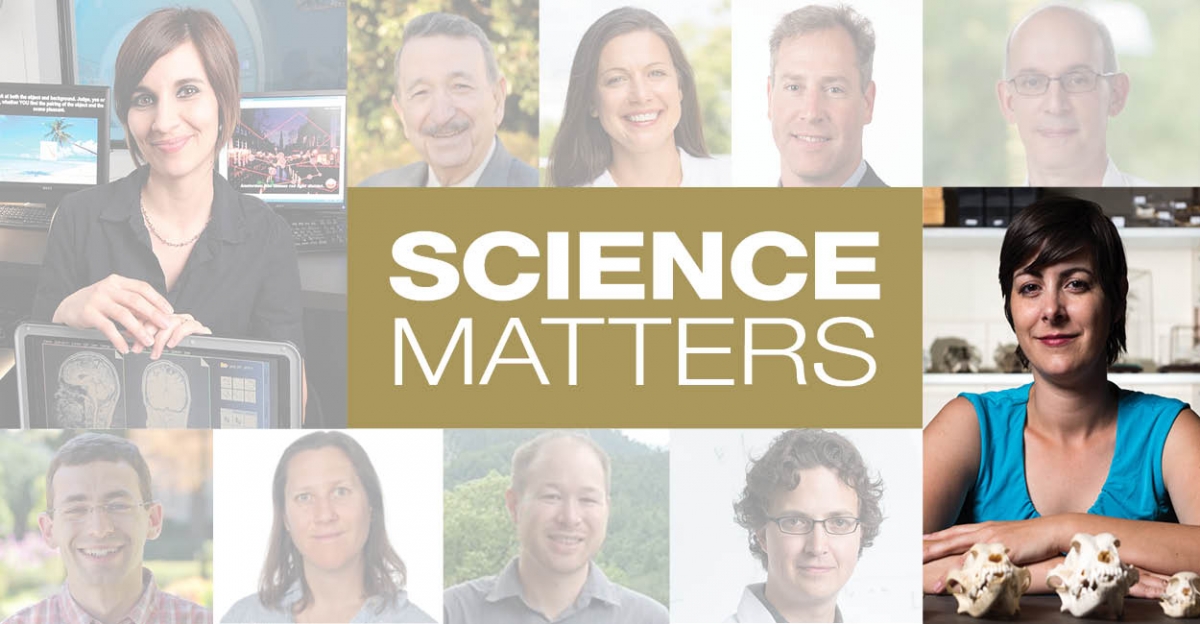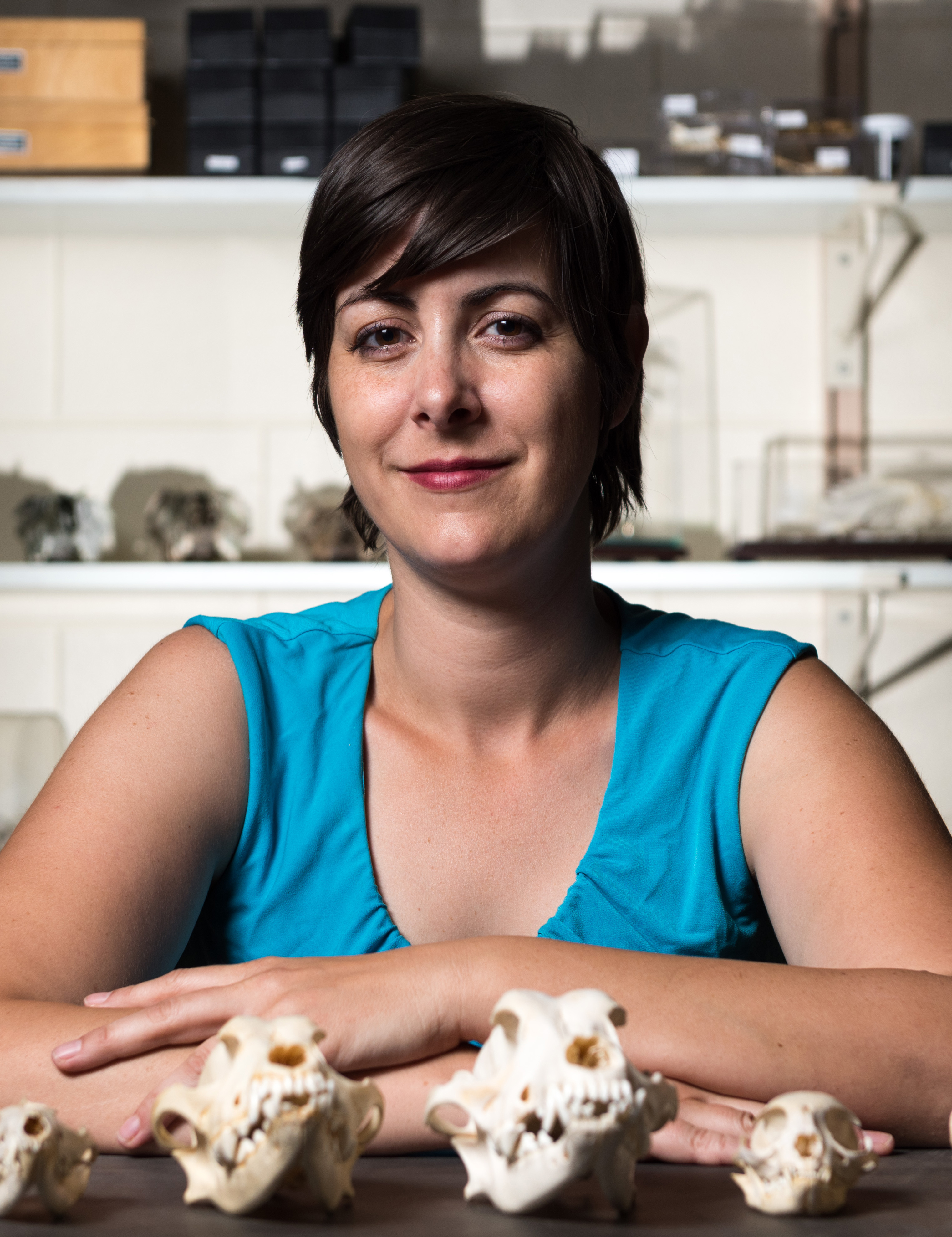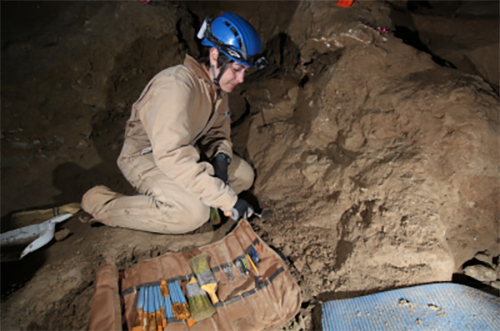
Download this episode
Jenny McGuire, an assistant professor in the School of Earth and Atmospheric Sciences and the School of Biological Sciences, has a tough commute to her summer research site: an 80-foot drop into a deep, dark Wyoming cave. McGuire studies fossils to better understand climate change’s impact on animal and human populations.
[upbeat music]
- Renay San Miguel:
-
This is “ScienceMatters,” the podcast for the Georgia Tech College of Sciences. I’m Renay San Miguel. Thanks for being with us.
Professor Jenny McGuire has joint appointments with schools of Biological Sciences and Earth and Atmospheric Sciences. So she keeps pretty busy on the Georgia Tech campus. But for the past three summers, she’s traveled to the rugged ranges of northern Wyoming, where she’s put on gloves, a helmet, and hiking boots, and she’s dug up fossils from the distant past in the hopes of finding clues to Earth’s future.
 Jenny McGuire:
Jenny McGuire:-
We’ve radio-carbon dated a lot of bones. We’re getting age ranges ranging from about 2,000 years all the way down to 30,000 years. And so we’re trying to really pinpoint exactly where each of those different stratigraphic layers is.
- Renay San Miguel:
-
That’s McGuire, speaking from deep inside Natural Trap Cave in Wyoming’s Big Horn Mountains. It’s from a new Wyoming Public Broadcasting documentary about the research going on there.
The cave is well-named. It’s a pitfall cave. A hole in its roof has trapped animals with only their bones and other fossils remaining to tell their stories to McGuire about life there 150,000 years ago. But McGuire believes Natural Trap Cave also has lessons to teach about how communities evolve over time and how they’ve been impacted by terrain, animal migration, climate change. Those lessons involve bringing pieces of Wyoming back to Georgia Tech.
[sifting sounds]
That’s McGuire’s students sifting through those rocks and remains here in a Georgia Tech lab for what McGuire calls “Fossil Wednesdays.”
Since 2016, anyone—students, faculty, the public— has been able to help her search the remains to find fossils. I spoke with McGuire about her research at Natural Trap Cave and about her Tech Lab called Spatial Ecology and Paleontology.
- Jenny McGuire:
-
What we’re really looking at is how communities shift across the landscape, right? So if we have glaciers that are coming really far south in North America, how does that drive the distributions of species on the landscape and where they’re living and whether or not there’s new communities or total remixing of communities or if communities just shift in a uniform way.
So really trying to understand how animals respond to changing climate and changing environments, so that we can get a better sense of how they’ll respond to increased warming and climate change that’s occurring today.
- Renay San Miguel:
-
And that ties into the mission statement that’s on the website for your lab, “Learning from the past to conserve the future.” Can you talk a little bit more about that?
- Jenny McGuire:
-
Right. So our lab works with quite a few landscape level conservation organizations who are interested in figuring out how to prioritize land purchases so that we can maximize biodiversity conserved. And we work to look at the models that they use and look at the strategies that they use and ground-test those strategies using the historical record and using our understanding of how things have responded in the past.
The thing about right now is that if you look at biodiversity right now as a way to say, we want to save as much biodiversity as possible, biodiversity now is not in a stable place, right? So we’ve got humans all over the landscape, building roads, building cities, hunting, really affecting all of the patterns of where natural systems are located and where animals are living. And we also are in, right at this moment, a period of really rapid climate change. So we are in a state of flux right now.
- Renay San Miguel:
-
What is it about Natural Trap Cave and its conditions that helps you try to figure all of that out,that helps you in your research?
 Jenny McGuire:
Jenny McGuire:-
So Natural Trap Cave is a really incredible resource for so many different reasons. It has fossils that go back 150,000 years. And so, this time period covers an incredible amount of change on the landscape within Wyoming, within North America.
150,000 years ago, it would have been an interglacial period. So it would have been warm like it is today. And then we have the onset of the last glaciation. And that peaked somewhere around 20-21,000 years ago. We have a lot of fossils coming out from 20,000 years ago that are really very solid, dense fossil concentrations from then. And then we have the retreat of the glaciers.
We have Native Americans coming into North America around 14,000 years ago. And Native Americans had huge impacts on the mammal ecosystems. And then we have Europeans coming into the system, right. And so each of these events marks really important transitions in overall mammal community structure. And this cave is able to record, just at a single point, all of these different types of community shifts.
[upbeat music]
- Renay San Miguel:
-
You have challenges, though, to be able to get to that location—the hole is at the top of the cave; it’s quite a drop; you have to repel in there. I was wondering if you had any kind of repelling experience, any kind of cave diving or spelunking experience before you started your work at Natural Trap Cave.
- Jenny McGuire:
-
Yeah, so I’d certainly gone into caves before, but I had not done any “vertical work”—is what it’s often called—in caves. So that’s the repelling and climbing back out of the cave. I had done indoor wall climbing when I was in graduate school. But it had been six years since I had done any climbing [laughs] when I went back to Natural Trap Cage, so when I started at Natural Trap Cave. So it was interesting. I was trained on the technique. And we trained off the side of like a seven-foot cliff. So I’m climbing; I’m looking down. It looks like I’m on a deck, right? [chuckles] It’s not very far down. I got the technique pretty quickly, and they were like, “All right, go ahead!” And so it was the first time I had done any work at height in like eight years. And so my first repel, I was—I have to say I was pretty nervous.
- Renay San Miguel:
-
And then you have to pull yourself up using this lever system using your legs and your feet and your arms to come back up. It sounds like quite a workout just everyday just to get to the research.
- Jenny McGuire:
-
Yeah, it’s a real challenge. I say that I have just a tough commute to do the paleontology. But it’s well worth it for the fossil resources that are in there. It’s also a challenge to get the fossils back out, right? So the material that I work on, I actually have to lug out bags of dirt so that we can pick through that dirt and look at the microfauna, look at the fossils. And having to lug out 80-pound bags of dirt in order to pick through that dirt, it limits the amount of fossils. You want to be kind of choosey about what you bring out, right?
- Renay San Miguel:
-
I’m sure. But what you do bring out ends up here at Georgia Tech, specifically, down the hall from this office where we’re speaking in Cherry Emerson where you, on Fossil Wednesdays in the afternoons, you allow students, anybody to come in and help you picking out fossils. How has that helped you with your research?
- Jenny McGuire:
-
You know, it’s incredible. Some of the most time-intensive portion of the research is going through these bits of rocks and bones that are all mixed together and picking the bones out. And we’ve had—some days we have 20 people show up and there’s just so many people coming and seeing what it’s like to be a paleontologist and experiencing a little portion of what it’s like to be at Natural Trap Cave. Because, I mean, we do the same sort of stuff at Natural Trap Cave as well. On those days when we’re tired and want to sit out, we sieve through the soil and we pick the fossils, you know, at the cave. So we really—I really appreciate the community and it’s been a great way to get everybody involved and excited about paleontology at Georgia Tech.
[upbeat music]
- Renay San Miguel:
-
So tell me what you have learned so tell me what you have learned so far in your research from Natural Trap Cave.
- Jenny McGuire:
-
So what we discovered was that during the Pleistocene, during the last glacial maximum when the glaciers are much closer to the cave, we end up having much moister habitats. It looks like it’s still relatively open habitat, but we have a lot higher proportion of rodents and, sometimes, frogs and turtles and things like that.
But then as we move in the Holocene, which is from about 10,000 years ago onward, then we start having a lot more lizards, a lot more snakes, a lot more high-desert sorts of species. And that’s reflected in what the communities look like today. We haven’t done the analysis yet to really look at whether we have a change in composition between the different kinds of herbivores that we have there, and that’s something that we’re really excited to do very soon.
So the idea is that before humans arrived and before the end of the last glacial maximum, there were lots of really large mammals on the landscape. So we had mammoths and we had lions and we had cheetahs, American cheetahs and American horses and camels. And we get all of these species in Natural Trap Cave. So we get all of those animals—wolves, really large Beringian wolves. And so we’re really interested in trying to see how the loss of all of those species affected the survivors, right? So do we end up having different relative abundances of the survivors before and after we lose all of these large animals on the landscape. And so that’s a really exciting analysis to come.
We’ve been trying to see whether or not there is a bias in the community’s, in the community composition, based on what kind of predator might have been eating those animals. And so we’re looking to see whether or not there are raptors or owls or mammalian carnivores are the ones—if we have a signal that one of those is eating the animals more than others. And so in order to do that, we look at the breakage rates of the bones. So we look to see how frequently the arm bones and the leg bones are broken. Because, you know, owls actually swallow their prey whole. And then they throw up these owl pellets. And the owl pellets preserve the bones, just totally intact.
Whereas raptors—you may have seen this, you know the eagle on the Mexican flag, right—they pick the bones apart. They pick the animal apart; every bone is broken—so almost 100 percent breakage rate. And mammalian carnivores are kind of like us. They kind of chew and they kind of don’t, right? So you have somewhere around 75 percent breakage rate for them. It varies, of course, by species. But what we end up seeing is something like 50 percent breakage rate. So it’s right in the middle.
We’re really not seeing a clear indication of breakage rate. And that’s actually good news. So it’s consistent through time. We’re not seeing that if I look at this community, it means that an owl ate everything. And if we look at this community, it means a raptor ate everything. And so then if you compare those two communities, all you’re comparing is food preference. You’re not comparing rate. So we don’t want to get that, and we’re not. We see that we’re not getting that.
And it ends up, what’s happening is that these wood rats, these pack rats, that live along the rim of the cave are going out and collecting all of the bones that they can find. And pack rats are one of the best, most consistent collectors and most consistent indicators of community composition, because they don’t care; they like anything shiny and hard. They bring it back to their nests and these are their treasures that they store in their nests. And these nests, they just hang out there for thousands and thousands of years. The wood rats past the nests on from mother to daughter every generation. And so, you end up with these nests full of bones, and the wood rats just kind of kick them down while they’re wandering around on the rim of the cave. Even though they’ve collected their treasures very carefully, they’re not very—they are a little klutzy [laughter]. So we have a really nice consistent source of data that is very representative of the community composition.
- Renay San Miguel:
-
Not only are you getting help from human scientists, but you’re getting help from pack rats as well to help you with your research. Is that an accurate way to describe it?
- Jenny McGuire:
-
Yes, that’s perfect. Yeah, we’re getting help from the rats and the humans—
- Renay San Miguel:
-
To collect your specimens!
- Jenny McGuire:
-
—to collect all of these great fossil specimens, yes.
[music] - Renay San Miguel:
-
That’s Jenny McGuire, assistant professor in the School of Biological Sciences and the Schools of Earth and Atmospheric Sciences. You can see her in the Wyoming PBS documentary at wyomingpbs.org. In the meantime, check out Fossil Wednesdays during the spring semesters in room 326 of Cherry Emerson. And McGuire’s lab website is mcguire.gatech.edu.
I’m Renay San Miguel. This is “Science Matters” from the Georgia Tech College of Sciences.
[music fades]


